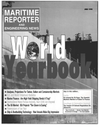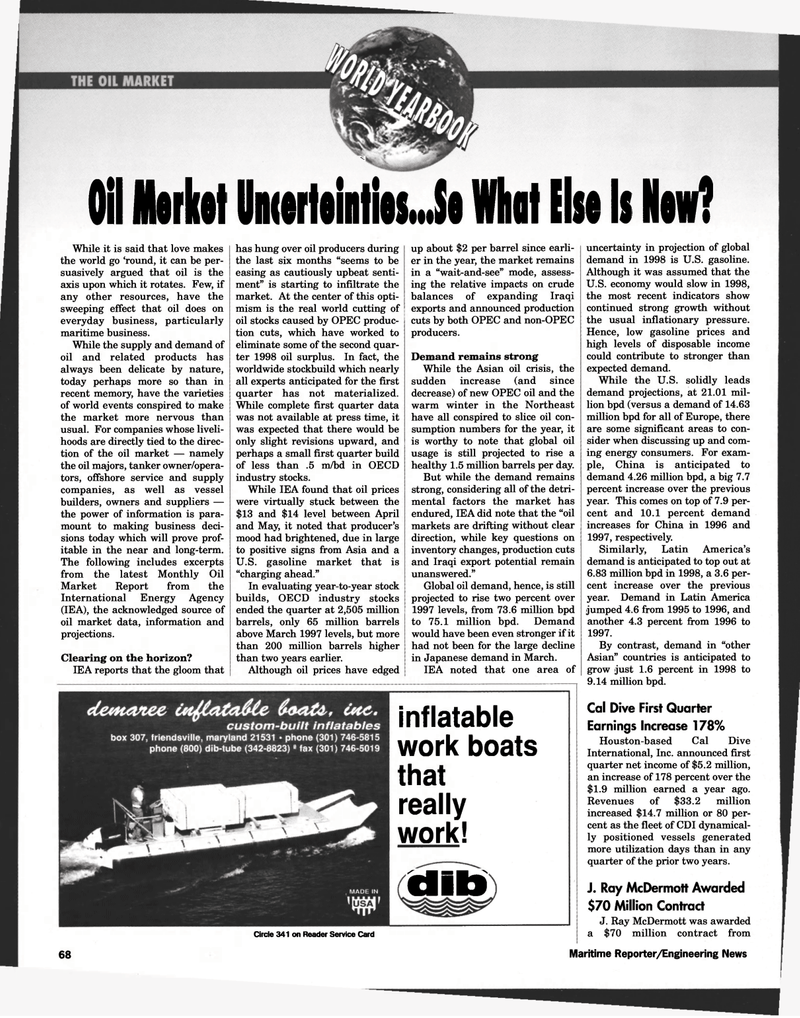
Page 73: of Maritime Reporter Magazine (June 1998)
Read this page in Pdf, Flash or Html5 edition of June 1998 Maritime Reporter Magazine
.••• TP
Oil Morkof Umerlointios Jo What Else Is Now?
While it is said that love makes the world go 'round, it can be per- suasively argued that oil is the axis upon which it rotates. Few, if any other resources, have the sweeping effect that oil does on everyday business, particularly maritime business.
While the supply and demand of oil and related products has always been delicate by nature, today perhaps more so than in recent memory, have the varieties of world events conspired to make the market more nervous than usual. For companies whose liveli- hoods are directly tied to the direc- tion of the oil market — namely the oil majors, tanker owner/opera- tors, offshore service and supply companies, as well as vessel builders, owners and suppliers — the power of information is para- mount to making business deci- sions today which will prove prof- itable in the near and long-term.
The following includes excerpts from the latest Monthly Oil
Market Report from the
International Energy Agency (IEA), the acknowledged source of oil market data, information and projections.
Clearing on the horizon?
IEA reports that the gloom that has hung over oil producers during the last six months "seems to be easing as cautiously upbeat senti- ment" is starting to infiltrate the market. At the center of this opti- mism is the real world cutting of oil stocks caused by OPEC produc- tion cuts, which have worked to eliminate some of the second quar- ter 1998 oil surplus. In fact, the worldwide stockbuild which nearly all experts anticipated for the first quarter has not materialized.
While complete first quarter data was not available at press time, it was expected that there would be only slight revisions upward, and perhaps a small first quarter build of less than .5 m/bd in OECD industry stocks.
While IEA found that oil prices were virtually stuck between the $13 and $14 level between April and May, it noted that producer's mood had brightened, due in large to positive signs from Asia and a
U.S. gasoline market that is "charging ahead."
In evaluating year-to-year stock builds, OECD industry stocks ended the quarter at 2,505 million barrels, only 65 million barrels above March 1997 levels, but more than 200 million barrels higher than two years earlier.
Although oil prices have edged up about $2 per barrel since earli- er in the year, the market remains in a "wait-and-see" mode, assess- ing the relative impacts on crude balances of expanding Iraqi exports and announced production cuts by both OPEC and non-OPEC producers.
Demand remains strong
While the Asian oil crisis, the sudden increase (and since decrease) of new OPEC oil and the warm winter in the Northeast have all conspired to slice oil con- sumption numbers for the year, it is worthy to note that global oil usage is still projected to rise a healthy 1.5 million barrels per day.
But while the demand remains strong, considering all of the detri- mental factors the market has endured, IEA did note that the "oil markets are drifting without clear direction, while key questions on inventory changes, production cuts and Iraqi export potential remain unanswered."
Global oil demand, hence, is still projected to rise two percent over 1997 levels, from 73.6 million bpd to 75.1 million bpd. Demand would have been even stronger if it had not been for the large decline in Japanese demand in March.
IEA noted that one area of uncertainty in projection of global demand in 1998 is U.S. gasoline.
Although it was assumed that the
U.S. economy would slow in 1998, the most recent indicators show continued strong growth without the usual inflationary pressure.
Hence, low gasoline prices and high levels of disposable income could contribute to stronger than expected demand.
While the U.S. solidly leads demand projections, at 21.01 mil- lion bpd (versus a demand of 14.63 million bpd for all of Europe, there are some significant areas to con- sider when discussing up and com- ing energy consumers. For exam- ple, China is anticipated to demand 4.26 million bpd, a big 7.7 percent increase over the previous year. This comes on top of 7.9 per- cent and 10.1 percent demand increases for China in 1996 and 1997, respectively.
Similarly, Latin America's demand is anticipated to top out at 6.83 million bpd in 1998, a 3.6 per- cent increase over the previous year. Demand in Latin America jumped 4.6 from 1995 to 1996, and another 4.3 percent from 1996 to 1997.
By contrast, demand in "other
Asian" countries is anticipated to grow just 1.6 percent in 1998 to 9.14 million bpd.
Cal Dive First Quarter
Earnings Increase 178%
Houston-based Cal Dive
International, Inc. announced first quarter net income of $5.2 million, an increase of 178 percent over the $1.9 million earned a year ago.
Revenues of $33.2 million increased $14.7 million or 80 per- cent as the fleet of CDI dynamical- ly positioned vessels generated more utilization days than in any quarter of the prior two years.
J. Ray McDermott Awarded $70 Million Contract
J. Ray McDermott was awarded a $70 million contract from inflatable work boats that really work! dib
Circle 341 on Reader Service Card 68 Maritime Reporter/Engineering News

 72
72

 74
74
